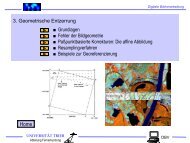Automatisierte Bestimmung der Bestockungsdichte in ... - Ladamer
Automatisierte Bestimmung der Bestockungsdichte in ... - Ladamer
Automatisierte Bestimmung der Bestockungsdichte in ... - Ladamer
Sie wollen auch ein ePaper? Erhöhen Sie die Reichweite Ihrer Titel.
YUMPU macht aus Druck-PDFs automatisch weboptimierte ePaper, die Google liebt.
Atzberger & Schlerf (2002): Ableitung von <strong>Bestockungsdichte</strong>n aus Orthophotos ....<br />
<strong>Automatisierte</strong> <strong>Bestimmung</strong> <strong>der</strong> <strong>Bestockungsdichte</strong> <strong>in</strong> Nadelwäl<strong>der</strong>n<br />
aus räumlich hochauflösenden Ortholuftbil<strong>der</strong>n<br />
Clement ATZBERGER & Mart<strong>in</strong> SCHLERF<br />
Universität Trier, Abteilung Fernerkundung, D-54286 Trier, Germany<br />
ZUSAMMENFASSUNG: Die vorliegende Arbeit beschreibt die Entwicklung e<strong>in</strong>es<br />
automatischen Tools zur flächendeckenden <strong>Bestimmung</strong> <strong>der</strong> <strong>Bestockungsdichte</strong><br />
aus hochauflösenden Ortholuftbil<strong>der</strong>n. In räumlich hochauflösenden digitalen<br />
Fernerkundungsdaten (10 –100 cm) treten Baumkronen normalerweise als separierbare<br />
Objekte <strong>in</strong> Ersche<strong>in</strong>ung. Dieser Umstand ermöglicht e<strong>in</strong>e automatische<br />
Identifikation <strong>in</strong>dividueller Baumkronen. Das vorgestellte Verfahren basiert auf<br />
e<strong>in</strong>er B<strong>in</strong>arisierung von SW-Orthophotos mit nachgeschalteten morphologischen<br />
Operationen und e<strong>in</strong>er darauf aufbauenden Objekterkennung <strong>in</strong> e<strong>in</strong>em 25 m x 25<br />
m großen gleitenden Fenster. Die Methode erlaubt e<strong>in</strong>e <strong>Bestimmung</strong> von Bestokkungsdichten<br />
<strong>in</strong> Nadelwäl<strong>der</strong>n mit e<strong>in</strong>er Genauigkeit von etwa ± 65 Bäumen pro<br />
Hektar bei <strong>Bestockungsdichte</strong>n zwischen 200 und 800 Bäumen pro Hektar. Information<br />
zur <strong>Bestockungsdichte</strong> können u.a. zur Bestandsabgrenzung verwendet<br />
werden, als a priori Information bei <strong>der</strong> Inversion physikalisch basierter Reflexionsmodelle<br />
sowie zur Initialisierung und Parametrisierung von Stoff- und Energieflussmodellen.<br />
SUMMARY: Automatic stem density estimation <strong>in</strong> coniferous forests from high<br />
spatial resolution orthophotos. In remotely sensed aerial images or digital orthophotos<br />
of high spatial resolution (10 -100 cm) tree crowns are typically visible as<br />
almost dist<strong>in</strong>ct objects. One important structural forest parameter, stem density,<br />
can be <strong>der</strong>ived through identification of <strong>in</strong>dividual tree crowns. A tool has been<br />
developed to automatically determ<strong>in</strong>e stem densities <strong>in</strong> coniferous forests from<br />
digital black-white orthophotos. The procedure is based on threshold<strong>in</strong>g of orthophotos<br />
followed by morphological operations and object identification us<strong>in</strong>g a<br />
mov<strong>in</strong>g w<strong>in</strong>dow. The method is capable of estimat<strong>in</strong>g stem density with an accuracy<br />
of approximately ± 65 trees per hectar for stem densities vary<strong>in</strong>g between<br />
200 and 800 stems per hectar. On the basis of the retrieved stem densities, regroup<strong>in</strong>g<br />
of stands can be organized to follow criteria other than those currently<br />
followed by forest <strong>in</strong>ventories, particularly when consi<strong>der</strong><strong>in</strong>g the relationship between<br />
average stand density and stand age. Moreover, estimated stem densities<br />
are useful <strong>in</strong> the <strong>in</strong>version of physically based forest reflectance models and for<br />
<strong>in</strong>itialization and parameterization of biogeochemical process models.<br />
KEYWORDS: remote sens<strong>in</strong>g, orthophoto, forest <strong>in</strong>ventory, stem density, tree<br />
crown del<strong>in</strong>eation, threshold<strong>in</strong>g, morphological operation, object identification,<br />
MATLAB, SFB 522, Idarwald, coniferous forest, Norway spruce, Picea abies<br />
Die Org<strong>in</strong>alversion dieses Textbeitrages ist für das Jahr 2002 zur Publikation angenommen <strong>in</strong>:<br />
Photogrammetrie-Fernerkundung-Geo<strong>in</strong>formatik<br />
15




